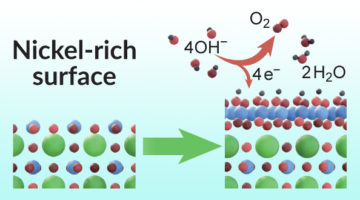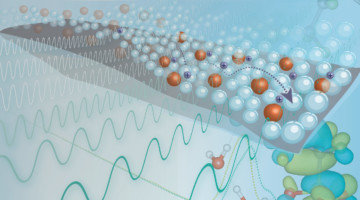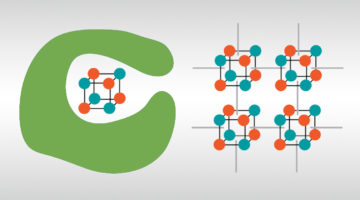An atomically precise surface probe helped researchers discover that a catalyst can be activated by tuning the composition of just one atomic surface layer. The work sharpens our understanding of how surface changes can improve the production of hydrogen fuel from water using efficient catalysts made of inexpensive materials. Read more »![]()
![]()
A 1-Atom-Deep Look at a Water-Splitting Catalyst
X-ray experiments revealed an unexpected transformation in a single atomic layer of a material that contributed to a doubling in the speed of a chemical reaction—the splitting of water into hydrogen and oxygen gases. This process is a first step in producing hydrogen fuel for applications such as electric vehicles powered by hydrogen fuel cells. Read more »
2D Electronics Get an Atomic Tuneup
Researchers demonstrated a promising avenue for controlling atomic ordering in semiconductor alloys by engineering frustrated interactions in a 2D transition metal dichalcogenide (TMD). The work could lead to improved semiconductor performance for next-generation electronics such as optoelectronics, thermoelectrics, and sensors. Read more »
How Water Promotes Catalysis of Methane to Methanol
Researchers unraveled how water helps catalyze the conversion of methane, the main component of natural gas, into methanol, a liquid fuel. The work supports the efficient production of methanol and other useful chemicals and could help reduce the amount of greenhouse gases released by the flaring and venting of methane. Read more »![]()
![]()
Water Improves Material’s Ability to Capture CO2
With the help of the ALS, researchers from UC Berkeley and ExxonMobil fine-tuned a material to capture CO2 in the presence of water. The parties have applied for a patent on the material, which was developed for use on the relatively humid flue gases emitted by certain natural gas power plants, a cleaner-burning alternative to coal. Read more »![]()
![]()
The Beauty of Imperfections: Linking Atomic Defects to 2D Materials’ Electronic Properties
Two studies reveal surprising details on how some atomic defects emerge in transition metal dichalcogenides (TMDs), and how those defects shape the material’s electronic properties. The findings could provide a more platform for designing 2D materials for quantum information science and smaller, more powerful optoelectronics. Read more »
Go With the Flow: Scientists Design Better Batteries for a Renewable Energy Grid
Researchers developed a versatile yet affordable battery membrane—from a class of polymers known as AquaPIMs. This class of polymers makes long-lasting and low-cost grid batteries possible based solely on readily available materials such as zinc, iron, and water. Read more »
Multimodal Study of Ion-Conducting Membranes
Using multiple x-ray characterization tools, researchers showed how chemical and structural changes improve the performance of a novel ion-conducting polymer (ionomer) membrane from 3M Company. The work provides insight into factors impacting the proton conductivity of ionomers used for fuel cells and the production of hydrogen fuel. Read more »![]()
![]()
Newly Discovered Minerals Reveal Anomalous Origins
Researchers characterized two highly unusual nickel-containing minerals, both unearthed in an ancient geological site in southern central Siberia. The findings extend our understanding of naturally occurring mineral species and varieties and provide useful insights into the environments leading to the formation of potentially valuable mineral ores. Read more »![]()
![]()
Molecular Framework Imparts Stability to Reactive Catalyst
Researchers have shown that a rigid metal–organic framework (MOF) can be used to stabilize core regions of a reactive catalyst that has potential for use in artificial photosynthesis. The framework immobilizes and preserves key reactive intermediates and affords a clearer view of how the catalyst’s structure correlates with function. Read more »









